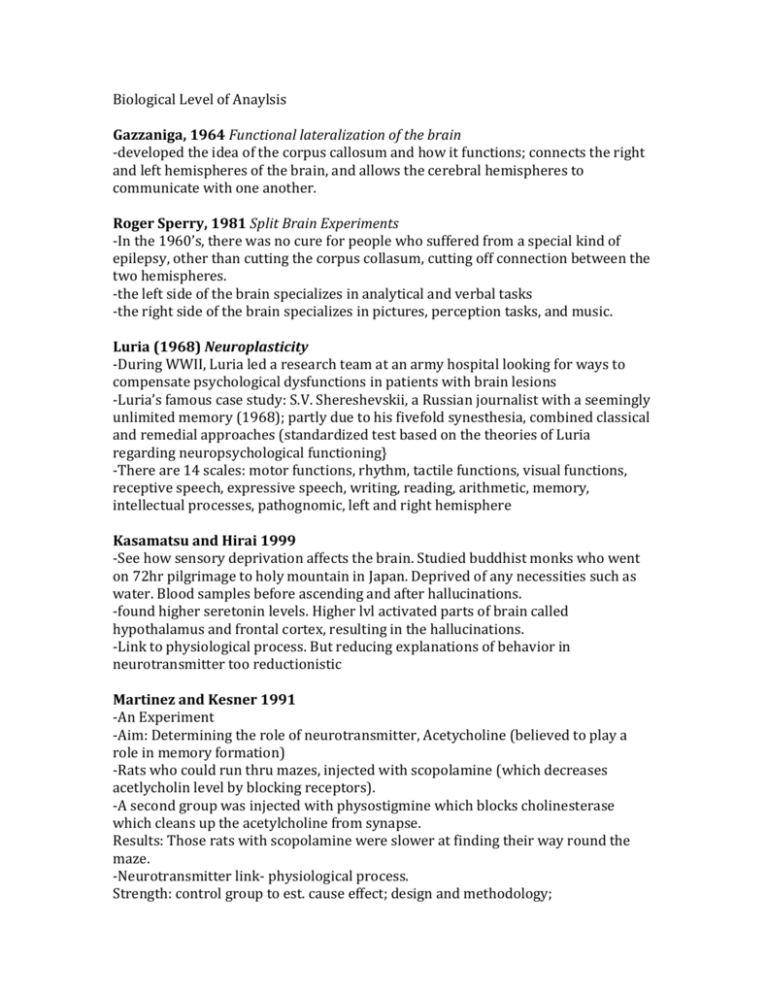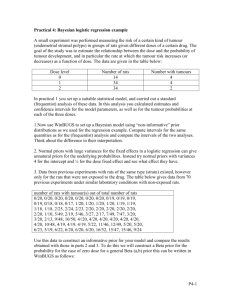File - IB Psychology
advertisement

Biological Level of Anaylsis Gazzaniga, 1964 Functional lateralization of the brain -developed the idea of the corpus callosum and how it functions; connects the right and left hemispheres of the brain, and allows the cerebral hemispheres to communicate with one another. Roger Sperry, 1981 Split Brain Experiments -In the 1960’s, there was no cure for people who suffered from a special kind of epilepsy, other than cutting the corpus collasum, cutting off connection between the two hemispheres. -the left side of the brain specializes in analytical and verbal tasks -the right side of the brain specializes in pictures, perception tasks, and music. Luria (1968) Neuroplasticity -During WWII, Luria led a research team at an army hospital looking for ways to compensate psychological dysfunctions in patients with brain lesions -Luria’s famous case study: S.V. Shereshevskii, a Russian journalist with a seemingly unlimited memory (1968); partly due to his fivefold synesthesia, combined classical and remedial approaches (standardized test based on the theories of Luria regarding neuropsychological functioning} -There are 14 scales: motor functions, rhythm, tactile functions, visual functions, receptive speech, expressive speech, writing, reading, arithmetic, memory, intellectual processes, pathognomic, left and right hemisphere Kasamatsu and Hirai 1999 -See how sensory deprivation affects the brain. Studied buddhist monks who went on 72hr pilgrimage to holy mountain in Japan. Deprived of any necessities such as water. Blood samples before ascending and after hallucinations. -found higher seretonin levels. Higher lvl activated parts of brain called hypothalamus and frontal cortex, resulting in the hallucinations. -Link to physiological process. But reducing explanations of behavior in neurotransmitter too reductionistic Martinez and Kesner 1991 -An Experiment -Aim: Determining the role of neurotransmitter, Acetycholine (believed to play a role in memory formation) -Rats who could run thru mazes, injected with scopolamine (which decreases acetlycholin level by blocking receptors). -A second group was injected with physostigmine which blocks cholinesterase which cleans up the acetylcholine from synapse. Results: Those rats with scopolamine were slower at finding their way round the maze. -Neurotransmitter link- physiological process. Strength: control group to est. cause effect; design and methodology; Limitation: animal study. Can results be generalized to humans? Are memory processes similar? Phineas Gage 1848 (Dr. Harlow) -(Longitudinal study) serious accident in which metal pole went through his skull and front of his brain. - Balance btwn intellectual abilities and emotional control destroyed. He had become highly agitated and irreverent. - Brain localization: shows correlation of certain injuries to diff places in brain (frontal lobe correlation to personality, social behavior, decision-making impulses, etc) Broca 1861 -Post-morten studies- Study Tan- he could only say the word “Tan.” (Case study) -Damage to left frontal lobe=unable to understand and make grammatically complex sentences. -Damage to this area= expressive aphasia Wernike 1950 -Left temporal lobe studied. -Case study- so can’t be generalized. Deals with understanding. -Link to language processing. -Damage resulted in Receptive Aphasia. James Olds and Robert Heath, 1950s -Research on rats. He devised experiment in which rats received electrical stimulation of the nucleus acubbens by pressing a lever. Rats willing to walk across electrified grids to get to "pleasure lever" -Rather pleasured, preferred this over drinking, or eating. -Animal studies how all drugs increase production of dopamine in nucleus accubens and reduce the production of seretonin. -Ethical considerations? Shocking animals and patients? Hetherington and Ranson (1942) - lesioned the ventromedial hypothalamus in rats, rats increased food intake and doubled their weight. - Hypothalamus acted as a brake on eating; now researchers question role - Ethics? Animal testing Hubel and Wiesel (1965) -brain could change as a result of the environmental input - Idea of neuroplasticity- ability to restructure brain - based on a lab experiment with rats Rosenzweig and Bennett 1972 -Two diff groups- one in enriched, stimulating environment while the other is in deprived environment with no toys. Rats spent 30-60 days in their respective environment, then studied. -Those in stimulating environment had increased thickness in cortex, implying better thinking, planning and decision-making. -Shows brain plasticity. Dendrite branching -Generalizable? Davidson 2004 -Involved 8 buddhist monks highly skilled at meditation and 10 volunteers who had been trained in meditation for one week. all meditate on love and compassionusing PET scan found all monks and 2 control experienced increase in # of gamma waves- when told to stop meditating, control groups' waves returned to normal, but monks stayed the same. -Meditation could have significant long-term effects on brain and way it processes emotions. Link to physiological processes. Link to emic etic. Rauscher 1993 -Mozart Effect- exposure to complex music will excite the brain and develop a more sophisticated ability to solve spatial abilities. -Link to changes in physiological processes based on environment. Thompson 2001 - found that when participants’ moods elevated, they improved, but if they didn’t elevate, did not show any improvement. -Thus, the Mozart effect not an example of plasticity, but just example that heighted attention increases learning. -Studies suffer from ecological validity- carried out lab settings. Link to disproving Mozart effect. Gallese 1996 -Neural messages electrical. Researchers hear crackle of electrical signals when neurons were activated. – so isolated neural response in monkeys reaching for peanut. -Everytime the monkey reached for a peanut, crackling noise was heard. Just by watching someone else reach for a peanut, monkey’s brain acted as tho the monkey were carrying out the behavior. -Link to mirror neurons. Link to Iacoboni. Link to animal generalization. Iacoboni 2004 -tried to generalize Gallese studies to humans. asked participants to look at human faces while undergoing fMRI. First imitate the faces shown, then simply look at the face -Same conclusion as Gallese. Same area activated. -Link to mirror Neurons Bouchard et al 1990- Minnesota Twin Study -longitudinal study since 1979 most crosscultural study to date. Mean age of identical twins raised apart is 41 years old. Before this, all were done with adolescents. Each twin completed 50 hrs of testing. -Bouchard determined a heritability estimate of 70% and 30% to other factors. -Link to nature v nurture. Link to intelligence. Link to environment on behavior. Criticicms- ethical concerns about way he reunited the twins- no adequate control to establish frequency of contact btwn twins prior to study Scarr and Weinbeg 1997 -Focused on parents raising both adopted and natural children. All children tested would have same upbringing with same environment with same parents. -Result- no significant difference in IQ correlation. The adoptive families were all wealthy smart, while the adopted children were lower class with low IQ parents. - Link to Minnesota Twin study. Link to intelligence. Wahlstein 1997 -Adoption studies. Transferred an infant from a low SES family to a high SES family.> improved IQ scores greatly. -Intelligence has a lot to do with environment as well as genetics. Strong interaction btwn genes and environment produce intelligence lvl. -Link to Intelligence. Link to Minnestoa Twin study. Nature v. nurture Matsuzawa 2007 -Examined spatial memory in young chimps. - flashed numbers for a brief moment and replaced with blank squares in which human and monkey participants had to remember which numeral appear in which location. - Humans made many errors, especially as the numbers were replaced with blank squares more quickly. but chimpanzees didn’t make more mistakes as this happened. conclusion- necessary adaptation for chimpazees to survive, but for humans, this skill no longer necessary so they surrendered this ability. - Link to evolutionary. Link to animal studies. Fessler 2006 - First determine if the participants had morning sickness. Then participants asked to imagine stomach-turning scenarios such as stepping on an earthworm. - women in first trimester scored much higher in disgust sensitivity than their counterparts in 2nd and 3rd trimester. - when morning sickness controlled for, response only held for disgusting scenarios involving food. - implication- natural selection helped compensate for increased susceptibility to disease during risky period in pregnancy, by increasing pickiness of food. Kim and Hirsch (1997) - Investigaed the brain processes of bilingual individuals. Using an fMRI, they studied people who had been bilingual from birth, and also people who had acquired a second language later in life. First group used same Broca’s area for thinking in both languages, but the second group activated a separate area for each language. Results suggest “critcal period” for development; brains develop differently based on each stage of a life a person is in when they learn certain things. Chugani (1999) - PET scan of glucose metabolism in newborn babies - The limbic system is active in newborns - Little activity in the cerebral cortex and frontal lobe Kasamatsu, (1999) Tokyo University Research Study - Examined how sensory deprivation affects the brain, Buddhist monks in pilgrimage - After 48 hours , of deprivation, hallucinations began - Serotonin levels increased in the monks, activated the hypothalamus Cornish and Clark (1987) Rational Choice Theory -Supported by Bennett and Wright: 1984 - Argue that criminal behavior is an outcome of reasoned decision-making process Based on idea that criminals seek benefit from crimes -Interviewed convicted burglars and asked them which factors most influenced their decision to robe a home: risk, financial reward, and ease of entry. -Questionable because based on “unsuccessful” burglars and many violent crimes aren’t planned out. Smith and Bond, 1993 -carried out 31 conformity studies - Belgian: 14%, Figi: 58% -Conformity is lower amount participants from individualistic cultures than from collectivist cultures (cultural dimension) Darwin (1859) -found correlations between bird characteristics (in the Galapogos Islands) and the environment -species develop to fulfill a specific ecological niche. -suggest that animals adapt through natural selection: characteristics that helped them become more equipped to survive. -suggests that animals have evolved, giving us reason to suggest that we can use animals for the study of humans. James Watson, 1990 Human Genome Project -map out all 23,000 genes and determine which genes influence which characteristics - Results: identified specific chromosomes associated with Alzheimer’s, alcoholism, schizophrenia, suicide, cognitive functioning, intelligence, and aging -Implications: there is a biological basis for psychological disorders such as schizophrenia and addiction.







